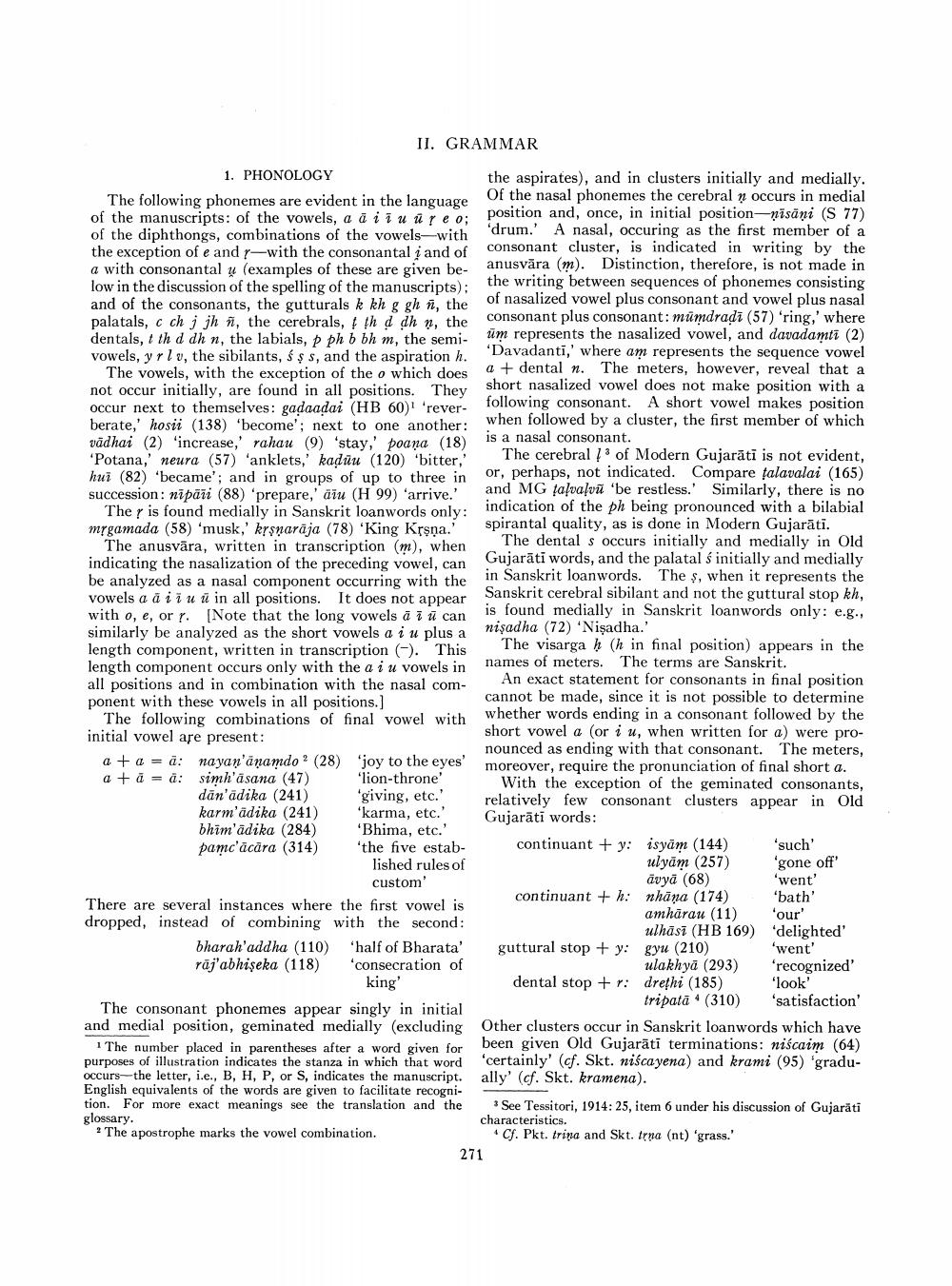________________
II. GRAMMAR
1. PHONOLOGY
the aspirates), and in clusters initially and medially. The following phonemes are evident in the language
Of the nasal phonemes the cerebral n occurs in medial of the manuscripts: of the vowels, a iiiuur eo;
position and, once, in initial position-nisani (S 77) of the diphthongs, combinations of the vowels-with
th drum.' A nasal, occuring as the first member of a the exception of e and with the consonantal i and of consonant cluster, is indicated in writing by the a with consonantal y (examples of these are given be
anusvāra (m). Distinction, therefore, is not made in low in the discussion of the spelling of the manuscripts):
the writing between sequences of phonemes consisting and of the consonants, the gutturals k kh g gh n, the
of nasalized vowel plus consonant and vowel plus nasal palatals, c ch j jh n, the cerebrals, I th d dh n, the
consonant plus consonant: mūmdradi (57) 'ring,' where dentals, I th d dh n, the labials, p ph b bh m, the semi
üm represents the nasalized vowel, and davadamti (2) vowels, y rlv, the sibilants, śş s, and the aspiration h.
'Davadanti,' where am represents the sequence vowel The vowels, with the exception of the o which does a + dental n. The meters, however, reveal that a not occur initially, are found in all positions. They
short nasalized vowel does not make position with a occur next to themselves: gadaadai (HB 60)' 'rever
following consonant. A short vowel makes position berate,' hosii (138) 'become'; next to one another:
when followed by a cluster, the first member of which vādhai (2) 'increase,' rahau (9) 'stay,' poana (18)
is a nasal consonant. "Potana,' neura (57) fanklets,' kaduu (120) 'bitter,'
The cerebral / of Modern Gujarāti is not evident, hui (82) 'became'; and in groups of up to three in
or, perhaps, not indicated. Compare falavalai (165) succession: nipaji (88) 'prepare,' ażu (H 99) 'arrive.'
and MG fafvalvū 'be restless.' Similarly, there is no The r is found medially in Sanskrit loanwords only:
indication of the ph being pronounced with a bilabial mrgamada (58) 'musk,' krsnarāja (78) 'King Krsna.'
spirantal quality, as is done in Modern Gujarāti. The anusvāra, written in transcription (m), when
The dental s occurs initially and medially in Old indicating the nasalization of the preceding vowel, can
Gujarāti words, and the palatal ś initially and medially be analyzed as a nasal component occurring with the
in Sanskrit loanwords. The $, when it represents the vowels a ă iiuü in all positions. It does not appear
Sanskrit cerebral sibilant and not the guttural stop kh, with o, e, orr. Note that the long vowels à ī ū can
is found medially in Sanskrit loanwords only: e.g., similarly be analyzed as the short vowels a iu plus a
nişadha (72) 'Nişadha.' length component, written in transcription (-). This
The visarga h (h in final position) appears in the length component occurs only with the ai u vowels in names of meters. The terms are Sanskrit. all positions and in combination with the nasal com
An exact statement for consonants in final position ponent with these vowels in all positions.]
cannot be made, since it is not possible to determine The following combinations of final vowel with
whether words ending in a consonant followed by the initial vowel are present:
short vowel a (or i u, when written for a) were pro
nounced as ending with that consonant. The meters, a ta = ä: nayan'ānamdo? (28) "joy to the eyes'
moreover, require the pronunciation of final short a. a + a = a: simh'āsana (47) 'lion-throne With the exception of the geminated consonants, dan'ādika (241) 'giving, etc.
relatively few consonant clusters appear in Old karm'ädika (241) *karma, etc.
Gujarāti words: bhim'ādika (284) 'Bhima, etc. pamc'ācāra (314) 'the five estab- continuant + y: isyām (144) such lished rules of
ulyām (257) 'gone off custom
ävyā (68)
'went' There are several instances where the first vowel is
continuant + h: nhāna (174) 'bath
amhārau (11) 'our dropped, instead of combining with the second:
ulhāsī (HB 169) delighted' bharah'addha (110) 'half of Bharata' guttural stop + y: gyu (210)
'went' rāj'abhiseka (118) 'consecration of
ulakhyā (293) "recognized king'
dental stop + 1: drethi (185) 'look'
tripatā (310) 'satisfaction' The consonant phonemes appear singly in initial and medial position, geminated medially (excluding Other clusters occur in Sanskrit loanwords which have
1 The number placed in parentheses after a word given for been given Old Gujarati terminations: niscaim (64) purposes of illustration indicates the stanza in which that word "certainly' (cf. Skt. niscayena) and krami (95) graduoccurs--the letter, i.e., B, H, P, or S, indicates the manuscript. ally' (cf. Skt. kramena). English equivalents of the words are given to facilitate recognition. For more exact meanings see the translation and the See Tessitori, 1914:25, item 6 under his discussion of Gujarati glossary.
characteristics. ? The apostrophe marks the vowel combination.
* Cf. Pkt. trina and Skt. trna (nt) 'grass.' 271




